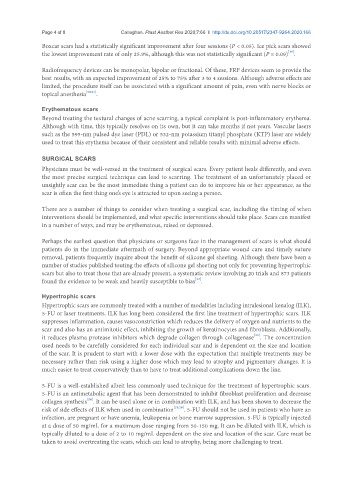Page 782 - Read Online
P. 782
Page 4 of 8 Callaghan. Plast Aesthet Res 2020;7:66 I http://dx.doi.org/10.20517/2347-9264.2020.166
Boxcar scars had a statistically significant improvement after four sessions (P < 0.05). Ice pick scars showed
[19]
the lowest improvement rate of only 25.9%, although this was not statistically significant (P = 0.09) .
Radiofrequency devices can be monopolar, bipolar or fractional. Of these, FRF devices seem to provide the
best results, with an expected improvement of 25% to 75% after 3 to 4 sessions. Although adverse effects are
limited, the procedure itself can be associated with a significant amount of pain, even with nerve blocks or
topical anesthesia [20,21] .
Erythematous scars
Beyond treating the textural changes of acne scarring, a typical complaint is post-inflammatory erythema.
Although with time, this typically resolves on its own, but it can take months if not years. Vascular lasers
such as the 595-nm pulsed dye laser (PDL) or 532-nm potassium titanyl phosphate (KTP) laser are widely
used to treat this erythema because of their consistent and reliable results with minimal adverse effects.
SURGICAL SCARS
Physicians must be well-versed in the treatment of surgical scars. Every patient heals differently, and even
the most precise surgical technique can lead to scarring. The treatment of an unfortunately placed or
unsightly scar can be the most immediate thing a patient can do to improve his or her appearance, as the
scar is often the first thing one’s eye is attracted to upon seeing a person.
There are a number of things to consider when treating a surgical scar, including the timing of when
interventions should be implemented, and what specific interventions should take place. Scars can manifest
in a number of ways, and may be erythematous, raised or depressed.
Perhaps the earliest question that physicians or surgeons face in the management of scars is what should
patients do in the immediate aftermath of surgery. Beyond appropriate wound care and timely suture
removal, patients frequently inquire about the benefit of silicone gel sheeting. Although there have been a
number of studies published touting the effects of silicone gel sheeting not only for preventing hypertrophic
scars but also to treat those that are already present, a systematic review involving 20 trials and 873 patients
[22]
found the evidence to be weak and heavily susceptible to bias .
Hypertrophic scars
Hypertrophic scars are commonly treated with a number of modalities including intralesional kenalog (ILK),
5-FU or laser treatments. ILK has long been considered the first line treatment of hypertrophic scars. ILK
suppresses inflammation, causes vasoconstriction which reduces the delivery of oxygen and nutrients to the
scar and also has an antimitotic effect, inhibiting the growth of keratinocytes and fibroblasts. Additionally,
it reduces plasma protease inhibitors which degrade collagen through collagenase . The concentration
[23]
used needs to be carefully considered for each individual scar and is dependent on the size and location
of the scar. It is prudent to start with a lower dose with the expectation that multiple treatments may be
necessary rather than risk using a higher dose which may lead to atrophy and pigmentary changes. It is
much easier to treat conservatively than to have to treat additional complications down the line.
5-FU is a well-established albeit less commonly used technique for the treatment of hypertrophic scars.
5-FU is an antimetabolic agent that has been demonstrated to inhibit fibroblast proliferation and decrease
collagen synthesis . It can be used alone or in combination with ILK, and has been shown to decrease the
[24]
risk of side effects of ILK when used in combination [25,26] . 5-FU should not be used in patients who have an
infection, are pregnant or have anemia, leukopenia or bone marrow suppression. 5-FU is typically injected
at a dose of 50 mg/mL for a maximum dose ranging from 50-150 mg. It can be diluted with ILK, which is
typically diluted to a dose of 2 to 10 mg/mL dependent on the size and location of the scar. Care must be
taken to avoid overtreating the scars, which can lead to atrophy, being more challenging to treat.

